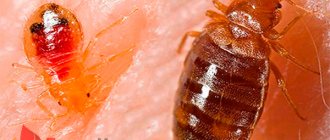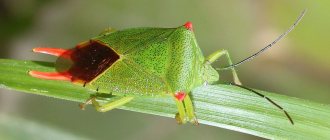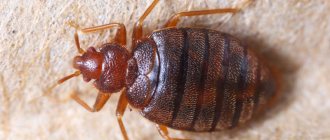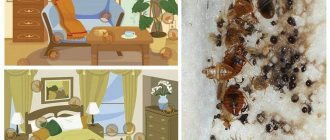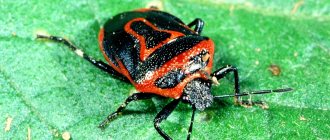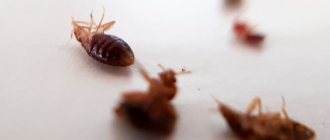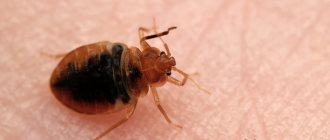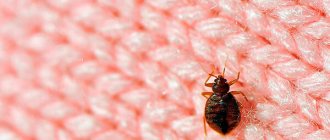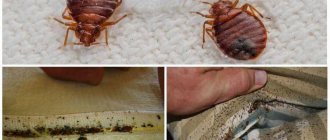In today's conditions, the likelihood of finding a bedbug in your apartment or private house is much lower than before. The reasons for this state of affairs are obvious - the successes of civilization both in terms of improving the sanitary and hygienic conditions of human life, and in terms of the emergence of new effective means of combating parasites.
At the same time, being around bedbugs can cause a lot of inconvenience. Therefore, it is extremely important to know what insects look like and to be able to detect them promptly and quickly. The article discusses the external signs of a bedbug, the differences between males and females, and the structural features of the insect’s body. Separate sections are devoted to a description of what the eggs and larvae of the parasite look like, as well as consideration of the differences between the bedbug and other representatives of this suborder of insects.
General information about the appearance of the insect
As noted above, bed bug (other commonly used names are apartment, linen, sofa, mattress, household, etc.)
is one of the types of bed bugs. It is widespread in different regions of the world, and its habitat coincides with that of humans. This is not surprising, given the peculiarities of the bedbug’s diet, which consists of human or animal blood.
The answer to the question of what an apartment bug looks like should begin by indicating the size of the insect. The length of the body of an adult varies widely - from 3 to 8-9 mm. As a rule, females are noticeably larger than males.
Depending on environmental conditions, quality and quantity of food, the color of the parasite varies from different shades of dull yellow to light and dark brown. The photo below shows a bedbug with a typical insect color.
Symptoms of infection
The most obvious evidence that there are bed bugs in the house is the discovery of an adult bed bug. At the same time, sometimes a living insect may indicate that the neighbors are being disinfested, and the surviving bloodsuckers have found a new home. Thus, when an adult is identified, the potential habitats of these parasites should be immediately inspected.
Bites on the body
The main symptom of bedbug infestation is bites that regularly appear on the skin. Red marks appear on the neck, back, cheeks and arms. Parasites do not bite in hairy areas; they choose places where the skin is thin and smooth. For this reason, children and women suffer more from these insects.
Bed bugs become active at night, so new bites can be detected in the morning immediately after waking up. Small red bumps are sometimes confused with an allergic reaction.
In this case, the bedbug bites are close to each other, forming a path. The number of red bumps on the skin increases every day along with the insect population, which is rapidly increasing. If the fight against parasites is not carried out, then a person can be bitten up to 300-350 times during the night.
Traces of blood on the bed
The substance that the parasite injects under the victim’s skin disrupts blood clotting. For this reason, a drop of blood appears at the site of the lesion, which, falling on the bed, leaves a mark. Bedding and waste products contaminate.
To remove stains, rinse the fabric in cold water. You can also remove traces with hydrogen peroxide (3-5%).
Hydrogen peroxide removes traces of blood stains after a bug bite.
The appearance of blackheads
Bedbugs are living creatures, so they have a digestive process and waste. Parasite feces are liquid and dark brown in color, but they quickly cool and become hard.
You can find excrement anywhere in your home. Most often, parasites accumulate near or on the bed. The smell of bedbug waste resembles bad cognac.
When the larva hatches from the egg, it molts several times as it grows. Each time it sheds its chitinous coating, which can be found on the floor, furniture, and windowsill.
Unpleasant smell
The sense of smell is a way for bedbugs to navigate in space, mate and notify their relatives of danger.
The aroma that these parasites exude is pleasant - sickly sweet, reminiscent of the smell of almonds or rotten raspberries. If there are a lot of insects in the apartment, the aroma becomes constant. If you smell this smell at least once in your life, you will no longer be able to confuse it with any other.
What can a bedbug be confused with?
It would seem that a detailed description of the appearance of a bug makes it easy to distinguish it from any other insects, harmful or not. However, the variability in the appearance of the parasite, which allows for serious variation in both size and body color, often leads to confusion. For example, quite often a well-fed bug can be mistaken for a cockroach. Photos of both insects are posted below, with the bedbug on the left and the cockroach on the right.
The similarity between the two parasites is obvious. They have similar sizes, similar coloration of an elongated segmented body. The main differences lie in several parameters. Firstly, the bug's body looks more rounded. Secondly, it darkens only after feeding. Thirdly, cockroaches are much more mobile and fast than bed bugs, which move at a low speed even in a hungry state, and are generally inactive when well-fed.
Another parasite with which the bedbug is often confused is the linen louse. Confusion often arises when comparing insect larvae. Just look at the photo of a linen lice and compare it with the images above.
To combat different insect pests, various methods and means are used. Therefore, it is extremely important to know what a particular pest, including a bed bug, looks like, and to be able to distinguish them from each other. To do this, you should consider in detail the most important external signs of bedbugs at different stages of their life cycle.
Is it possible to crush a parasite with your hands?
Bedbugs are rather fragile insects, but their flat body is given to them by nature just so that they survive, because it is quite inconvenient to catch a flat object and try to crush it. However, this can be done even in this state. It is, of course, more difficult to do this with your fingers.
Bedbugs can easily be choked by your fingernails, like fleas, so killing them this way is quite easy and simple. It simplifies even more when the parasites drink blood. Their abdomens swell to a size that is sometimes twice the size of the bedbugs themselves, after which they turn into a kind of capsule with blood, which is not difficult to simply flatten with your finger.
Sometimes this can be done even unconsciously, simply by leaning your body on a well-fed bug in a dream. You can notice this by small specks of blood. It is even easier to crush young bedbugs, because their body coverings are fragile and soft.
What does a hungry and well-fed bug look like?
First of all, it is necessary to note the effect of food intake on the appearance of the bug. Perhaps no other insect living near a person changes its appearance so noticeably during feeding. An important feature of the parasite is its rapid saturation, for which the bug only needs 8-10 minutes.
The changes occurring in the appearance of the bug are obvious and are as follows:
- the body rapidly elongates and becomes oblong from almost round;
- the size of the insect increases significantly, it becomes more noticeable and inactive;
- the body color changes from translucent and yellowish or light brown to dark red and even burgundy. After a few minutes - after the blood has clotted - the color of the parasite may turn dark brown or almost black.
In the process of digesting food, the parasite’s body gradually “deflates”, decreases in size and takes on its usual shape. Therefore, it seems quite logical that it is much easier to detect and destroy a well-fed bug, large, bright and inactive. Moreover, after eating, the insect can spend several days in a shelter, where finding it is very problematic.
Life cycle and reproduction
The month of an insect's life is during the larval phase. During this period of time, she is unable to reproduce. However, the rest of the time, females actively lay eggs, and males act as inseminators.
A female bedbug is capable of laying about 500 eggs over its entire life span. The larva hatches on the 5th day. In the larval stage, the parasite cannot reproduce. After a month, the larva turns into an adult parasite and is able to independently breed offspring. The average lifespan of an insect is 1 year. At low indoor temperatures, viability decreases and the parasites go into suspended animation.
At temperatures above 30 degrees, life expectancy is reduced, but the number of eggs hatched increases significantly. Bedbugs reproduce through traumatic insemination. At the same time, the male pierces the female’s abdomen with his subcutaneous genital organ and injects the seed into her. As a result, the seed enters the spermatheca where it is in a viable form. The process of laying females continues until the reserves in the spermatheca are depleted. Parasites have high viability because they have the ability to survive in the most unfavorable conditions. With insufficient food or unfavorable temperatures, insects fall into suspended animation. They can spend about a year in this state. When comfortable conditions arise and a food source becomes available, the parasites return to their previous lifestyle.
How to distinguish a female bedbug from a male
In bed bugs, as in a significant part of other insects, females are somewhat larger than males. However, it is extremely difficult to distinguish them by this or some other characteristics. The fact is that deviations in size are in the vast majority of cases insignificant and amount to 1-2 mm. Much more serious differences in size, for example, between a young and an adult bedbug.
When answering questions about what a female bedbug looks like and how it differs from a male, a more rounded abdomen is often mentioned. But even this sign is very difficult to detect with the naked eye in practice, and it is not necessary. The fact is that both males and females of the parasite are subject to destruction. Moreover, gender, unlike food intake, does not in any way affect the danger or likelihood of detecting a bedbug.
Bedbug nests in the photo
Actually, bedbugs do not form organized nests like wasps and especially ants. They simply hide during the day in the most suitable places, and since there are much fewer such places in the room than there are bedbugs themselves, these parasites can accumulate in huge quantities in the most comfortable shelters. In these places there are the bugs themselves, both adults and nymphs of all ages, eggs, remains of the chitinous covers of the larvae, excrement, and in general they look very unpleasant.
For example, here is a typical bedbug nest on a sofa upholstery:
And here the video shows the same accumulation, only on a blanket, which is generally atypical for bedbugs - they prefer to settle on stationary surfaces that are not disturbed by people:
Here is another place for bedbugs to hide, rest and breed, which completely covered one side of the mattress on the bed:
The largest such “nest” that we saw caught the eye of exterminator Kostya in an apartment near Moscow - it was about 80 cm in diameter and was located in the sofa. It is difficult to say how many parasites there were in it, but the sight was, to put it mildly, repulsive.
By the way, this is what a cluster of small larvae looks like right on the mattress:
It was precisely these young individuals that the students we have already mentioned mistook for some strange spiders. But they were definitely sure that these were not bedbugs.
Such hiding places cannot be called nests, because there is no organization or order in them. For example, in the nests of wasps, termites or ants, strict order reigns: the queen lays eggs, the workers look after her, the brood, the nest itself, obtain food, and protect the nest from enemies. All this is not present in bedbug clusters:
- There is no queen that lays eggs alone - all adult females lay them;
- There are no individuals who would maintain order here - everything in such a shelter accumulates spontaneously, complete disorder reigns here;
- The nest is not protected in any way by anyone, and when it is opened, some of the bugs try to run away, the other part hides, hoping that they will not be noticed;
- There is no hierarchy in such a cluster. Bedbugs simply accumulate here, spend daylight hours here, reproduce and die here.
By the way, you have probably already noticed that almost everywhere in such places of accumulation you can see black dots that look like balls. You probably already guessed what it is...
Appearance of bedbug eggs and larvae
go through three stages of development in sequence before reaching adulthood The first is an egg, the second is a larva, the third is an imago (another name for a full-fledged adult individual capable of reproduction). The appearance of the last stage of development is described above. Here it is necessary to consider what the eggs and larvae of the insect look like.
What do bedbug eggs look like?
Bedbug eggs are small, translucent, elongated spheres with a characteristic white color. They are often mistaken for waste products or blood digested by insects. However, in reality the eggs look exactly as described above. To get an idea of the size, just look at the photo in which the eggs are shown together with an adult bug, having a body length of up to 8-9 mm.
It is important to note that this stage of parasite development is the most resistant to chemicals. Moreover, to completely destroy bedbugs and prevent their reappearance, it is necessary to eliminate all insect clutches.
What do small bugs look like?
Unlike some other insects, bed bugs do not develop pupae or nymphs. The larvae of the parasite look almost like an adult insect, differing only in their smaller size and slightly lighter color. The photo clearly demonstrates the changes that occur as the larvae mature and form a full-fledged bedbug capable of reproducing.
Even a quick glance at the image shows how the size of the bug’s body gradually increases while the color darkens. No other significant changes occur - neither in appearance, nor in the diet, nor in the lifestyle of the parasite.
The standard increase in the length of the larval body is 1 mm after each moult and meal. The diet of small bugs is approximately one meal every week or half a month. Thus, after a month and a half, the larva becomes an adult.
Danger of bites
Researchers are still debating why bed bugs are dangerous to humans. So far, it has not been possible to scientifically prove the fact that bedbugs transmit infections. However, assumptions regarding the fact that arthropods can infect humans with smallpox, hepatitis B, tularemia, and anthrax still exist. Linen parasites cause the greatest harm to humans through their bites. One bug can leave a chain of up to seven bites in a row on an adult or child. By the way, parasites prefer children to adults. Babies have more delicate skin that is easier to bite through.
The table lists the main dangers that bedbug bites entail and how to combat them. But before taking any medications, consult your doctor. And immediately after detecting damage to the skin, treat the bite site with an antibacterial agent (spray, liquid or ointment), and apply cold.
Table - Why bedbug bites are dangerous
| State | The Right Action |
| Allergy | — Primary treatment of the affected skin area; - taking an antihistamine |
| Anemia (in young children) | — Primary disinfection; — consultation with a pediatrician; - taking vitamins high in iron |
| Anaphylactic shock | Urgent ambulance call |
Despite the unproven hypothesis that bedbugs are carriers of diseases, it is better not to touch the bite site with dirty hands, and it is advisable to treat the wound yourself - even before consulting your family doctor.
Stress as a consequence
Among all the consequences of bedbug bites, the most serious and difficult to treat is stress. The reasons for its development may be as follows.
- Insomnia. As well as a total lack of sleep due to insect attacks at night.
- Depression. Usually develops after prolonged stress in squeamish people. The thought of sleeping on a bed with bedbugs haunts a person, exhausts him psychologically.
- Nightmares. For young children, bedbug bites are even harder to come to terms with. It is not always possible to explain to the baby what exactly is happening and when it will stop. The child begins to live in a parallel reality, new fears appear, and colorful dreams give way to nightmares.
Features of the body structure of a bed bug
A description of what an apartment bug looks like without considering the structure of its body will be incomplete. The body of an insect consists of three main elements - the head, thorax and abdomen, the last two of which have a segmented structure. The indicated sections are united into a single organism by a chitinous cover, strong and dense, covered with short and thin hairs (see photo).
It is advisable to consider each of the sections of the bug’s body in a little more detail. The head is deservedly considered the most important part of the insect. It contains:
- two convex eyes with a high level of light sensitivity;
- organ of touch and smell in the form of long antennae. They play a vital role in all movements of the bug and its orientation in space;
- a proboscis curved under the abdomen, which is used to pierce the skin of the victim and suck out blood. It straightens immediately before eating and contains two channels. The first is used to inject saliva containing a special anesthetic enzyme into the blood, and the second is used directly to suck out the blood and transport it to the bug’s digestive system.
The insect's thorax is formed from three segments. The same number of pairs of legs are attached to them. In the upper part of the second segment there are two shortened elytra, which, due to their uselessness, are practically invisible. A bedbug does not have wings, so the parasite, contrary to popular myths, is not able to fly. A similar misconception is the insect's jumping, which is also impossible due to the structural features of the parasite's legs.
The number of segments on the abdomen of the parasite is usually 10. Spiracles are located along their edges. Behind the third pair of legs on the body of the bug there are glands, the purpose of which is to secrete a strongly odorous secretion, which occurs at the moment of danger. The genital organ and posterior opening of the insect are quite logically located on the last segment of the abdomen.
Bedbug mouthparts
Representatives of the order Hemiptera are called arthropodists. The main characteristic of bedbugs is the piercing-sucking type of mouthparts. It is characteristic of insects that consume only liquid food. Phytophages suck cell sap, predators suck nutrient fluid from the prey, and ectoparasites suck blood. In the piercing-sucking modification, the lower lip became a tube called the proboscis. The upper jaws (mandibles) and lower jaws (maxillae) have lengthened to two thin spines. These are bristles that are used to pierce. The proboscis has a segmented structure. In a calm state, it is retracted into a special recess on the chest.
The bedbug's mouthparts have 2 channels; through the lower one, saliva is supplied to the puncture site, and through the upper one, food is sucked in. The feeding of the parasites is as follows: the bug clings to the skin with jagged mandibles and pierces it with bristles, pushing them to the blood vessel. An anesthetic substance is injected through the salivary duct, preventing the person from feeling the bite. They require about 7 ml of blood until they are completely saturated. During the night, several punctures appear on the human body, the bug looks for a convenient place to feed.
Information. After saturation, the parasite becomes more noticeable, and its spherical shape makes it vulnerable to mechanical stress.
A common characteristic of all bedbugs is the same structure of the oral apparatus. But at the same time, the structure of the proboscis depends on the type of food consumed. In phytophages that feed on plant sap, the organ is long and weak. Predators are distinguished by a shorter and more powerful proboscis, shaped like an arc. In blood-sucking parasites, the proboscis is equipped with sharp bristles. Saliva contains anticoagulants and anesthetics. Bites from domestic bugs lead to an allergic reaction in the form of itching and redness, but the insects rarely transmit disease.
The structure of the piercing-sucking apparatus of a bed bug
External differences between bed bugs and other species of the suborder
Bed bugs are representatives of a very numerous suborder of insects of the same name. The appearance of other varieties can vary widely. Some of the most striking and original representatives of this suborder in terms of external parameters are presented in the photo.
The size of the largest bugs, for example, the giant belostomy, which belongs to the family of water bugs, reaches 10-12 cm. In Russian climatic conditions, you can find a garden bug that is similar in size to a bed bug. The wood stink bug looks somewhat larger. But all of them are not dangerous for humans, since they do not use his blood as food.
It must be remembered that only one type of truly dangerous bug can be found in a person’s home - the bed bug. In addition to the main one, this parasite goes by many additional names, the most common of which are: linen parasite, mattress parasite, clothing parasite, home parasite, room parasite, furniture parasite, human parasite, blood parasite, etc. The list of colloquial names for insects can be continued for a very long time. The main thing is to understand that we are talking about the same type of parasite that feeds on human blood.
Some types of bedbugs that feed on the blood of animals, such as bats or pigeons, also belong to the bed bug family. They look almost the same as the parasites described above that can be found in a person’s home.
How to detect bedbugs in your home
To quickly and effectively eliminate parasites, you need to find their nest. Thanks to their parasitic lifestyle, they have to hide in secluded places located not far from a sleeping person. You need to start your search in the bedroom and living room, where most of the time a person sleeps or sits motionless.
Bedbugs like warmth and darkness. Most often they settle under the mattress, in the sofa, in the folds of bedding or the seams of upholstered furniture. They prefer certain types of material:
- textile;
- plastic;
- tree;
- paper.
They don’t like metal structures, cold and moisture and move away from there.
Common Habitats
- Bed frame, mattress, upholstered furniture, blankets, pillows, bedding.
- Storage places under the sofa are drawers for linen.
- Furniture in the bedroom - chests of drawers, lamps, clocks, paintings, photographs.
- Curtains, cornices, blinds, switches, sockets.
- Cracks in the walls and places where wallpaper and parquet have peeled off.
- Skirting boards.
- Carpets and carpet runners.
- Books on the shelves.
- Window and door frames, mirrors on the walls.
- In pets' sleeping areas.
Prepare yourself for the fact that the picture you see will be unpleasant. How this can be, look at the photo.
Bedbug in bed
Bedbugs photo
Bedbug on hand
Another image of a family of parasites in the next photo.
Three bedbugs
The opinion that bedbugs live in old and dirty rooms is considered incorrect. This is far from true. They can calmly exist in a house where there is complete cleanliness, chic and shine. Therefore, do not waste time, but start searching for bedbugs.
Recommendations from professionals for identifying and exterminating bedbugs
Finding a bedbug or an insect suspiciously similar to one in your home requires taking immediate action. The first and main rule of behavior in such a situation is to quickly find out who exactly the owner of the apartment or house happened to meet. The article provides quite a lot of signs that allow you to determine whether we are talking about a bedbug, a very dangerous and unpleasant neighbor, or some other insects. In addition, a large amount of useful information, including large and detailed images of the bedbug, can be easily found on the Internet.
If you cannot independently determine the type of insect, it is advisable to contact professionals who specialize in insecticidal treatment of premises. In this case, it is better to take unnecessary safety measures than to allow bedbugs to breed in the house. Moreover, the rate of increase in their population is very high. Therefore, even a slight delay lasting several days is fraught with unpleasant consequences.
In order to distinguish eggs, larvae and adults of bedbugs from other insects, it is advisable to use several signs:
- Compared to outwardly similar cockroaches, bedbug larvae are much less mobile and active, even if they are hungry;
- another important difference between a cockroach and any stage of bedbug development is its larger size, which quickly reaches and then exceeds one to one and a half centimeters;
- unlike ants, small bugs, which generally look similar, do not have a clearly defined and characteristic waist;
- The main difference in the appearance of fleas and bedbug larvae is the lighter color of the latter. Another significant difference is the much higher motor activity of fleas;
- Ixodid ticks, which often enter the house in the warm spring-autumn period, have 4 pairs of legs. A bedbug has 3 of them.
It’s not just appearance that helps distinguish parasites of one species from another. For example, the usual habitat of an apartment bug is the frame of a bed or sofa, in other words, near a person’s sleeping place. Most other insects - cockroaches or ants - prefer to choose a kitchen or a place for storing and collecting garbage for living. Another distinctive feature of a bedbug is the chaotic nature of the bites and, as a result, the marks from them. At the same time, lice bites form peculiar paths, that is, they suggest the presence of some ordered principle.
Where do bedbugs come from in an apartment?
These insects love to travel. They happily change from one home to another, and quickly adapt to new living conditions. Often people themselves help them in this, but they don’t even know about it.
- You can safely bring them into your home from guests or bring them back from vacation.
- Buy furniture infested with bedbugs. Not only consignment furniture can be infested with bedbugs, but also completely new furniture.
- Place furnishings in your home from the place where the insects lived. Before you bring anything into your home, it is advisable to inspect it.
- A pet can bring a bedbug into your apartment.
- There are times when they appear in the house thanks to birds and bats.
- Cracks in the walls and ventilation hatches open the way for insects from neighbors. In 1 minute, the bug crawls more than 1 meter. Capable of covering a distance of 30 meters. If there is an apartment with bedbugs in a multi-storey building, then there is a chance that they will appear everywhere.
Bedbugs are active at night. When visiting an infected premises during the day, you can rest assured that they will not move to you. In bright light, insects hide in secluded crevices and disguise their existence. If you had to spend the night in such a room, then during this time the female will have time to lay eggs in the folds of her clothing or settle there herself. By bringing them into your home, you will start a new population of bedbugs.
Conclusion
Any suspicion of a bedbug requires a thorough inspection. To carry it out, you need to know what the parasite looks like and how it differs from other insects. If it is confirmed that bedbugs live in an apartment or house, you must immediately contact specialists to carry out insecticidal treatment or carry out similar protective measures yourself.
How to get rid
To decide on the method of destruction, you need to understand how many parasites live in the apartment. To get rid of bedbugs yourself, you can use insecticides, among which are the following:
- liquid Karbofos;
- liquid Executioner;
- spray Klopomor;
- pencil Mashenka;
- Get microcapsule product.
You can fight bedbugs in the following ways:
- Freezing or heat treatment. At the same time, the heating system may suffer from the cold, and renting a heat gun is expensive.
- Collection with a vacuum cleaner or by hand. This method is labor-intensive and not very effective.
The most reliable way to get rid of parasites is to call an exterminator. Specialists come with special equipment and products that are toxic to insects but safe for humans. Since these bloodsucking creatures quickly migrate from one apartment to another, it is advisable to simultaneously treat the entire entrance.
In order for pest control to bring maximum results, you should move the furniture away from the walls and free the edges of the carpets before the specialist arrives. All food, dishes and personal hygiene items must be removed from the house. After treatment, the apartment is wet cleaned and ventilated.
What are house bugs like?
The most important thing and the first thing to start with is: let’s define the concept of what a house bug actually is. Strictly speaking, there is no biological species with this name. In common parlance, house bugs are bedbugs whose entire life cycle and reproduction occurs only in human housing. Of the several thousand bedbugs known to science today, only one species is capable of living and reproducing in human housing in Eurasia, in particular in Russia and Ukraine: the common bedbug, in Latin Cimex lecturarius. No other bedbugs live permanently in human housing. At least in the temperate climate of the Northern Hemisphere. Sometimes shield bugs can fly here, or soldier bugs or predator bugs can crawl here, but they are not able to live permanently, much less reproduce, in human housing.
This means we need to figure out exactly what bed bugs look like.
Reviews from people
Ekaterina, 37 years old, St. Petersburg: “Two years ago, our family faced a problem: bedbugs infested our apartment. At first I noticed small red spots on my son’s back and assumed it was an allergy. Then she discovered bloody specks on the bed linen. Then they thought about bedbugs, turned the sofa over, and there were whole colonies there. To remove insects, they turned to specialists. Exposure to cold fog helped.”
Alexander, 45 years old, Novosibirsk: “When bedbugs lived in our house, it was terrible. It’s not clear where they came from, but we found unpleasant insects everywhere: in mattresses, clothes, under the sofa and baseboards. It took a long time to get rid of them, using various methods. I don’t know what product worked, but I’m glad there are no more bedbugs.”
Irina, 52 years old, Krasnodar: “I discovered these insects at home after visiting a neighbor. Perhaps she brought them on her clothes. I noticed red spots on my body in the morning, then itchy skin appeared. To kill bedbugs, I used both folk and store-bought remedies. However, the effect is temporary: they first disappear, then appear again.”
Lifestyle
These are parasites that are nocturnal. Bed bugs come into the world only in one case - if living conditions have deteriorated so much that the insects are forced to begin an active search for food.
Bedbugs prefer to make as little effort as possible to obtain food. Therefore, they choose people with thin, delicate skin as their favorite victims - children come first, then women, and only then men, who have denser and thicker skin.
Parasites can find their prey thanks to their smell - bedbugs have a well-developed sense of smell. Pests can detect victims at a great distance, so they quickly spread throughout all the rooms of the apartment they enter. And they also easily move from room to room through cracks in the ceilings.
The bed bug belongs to the genus Cimex lectularius and feeds on the blood of warm-blooded animals.
